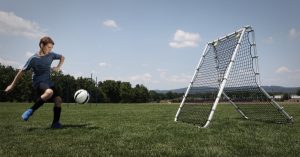Podcast: Play in new window | Download
Subscribe: Apple Podcasts | RSS
 The Central Regional Championships for the US Youth Futsal Nationals was in Kansas City last weekend. I had one team win and qualify for Nationals while the other had a tough weekend. They played some very good teams but didn’t play as well has they have recently. I’ve said before that the only thing consistent about young teams is there inconsistency.
The Central Regional Championships for the US Youth Futsal Nationals was in Kansas City last weekend. I had one team win and qualify for Nationals while the other had a tough weekend. They played some very good teams but didn’t play as well has they have recently. I’ve said before that the only thing consistent about young teams is there inconsistency.
I can point to the long holiday break and missing players for other sports commitments as reasons but these are just part of the challenges of training and competing with young players.
 This week’s question comes from Ryan
This week’s question comes from Ryan
He’s asking about player positioning. Ryan says,
“A week ago on one of your podcasts you mentioned the concept of trying to get all players equal playing time as well as equal time at each position for growth.I agree, however I sometimes struggle with the implementation.
How do you ensure you are giving out time and positions equally if you are the only coach on the field.
My co-coach spends a lot of time scripting out the starting lineup and each rotation before every game, but that takes a lot of time and can be problematic with injuries and late arrivals or absences.
I like to be a bit more fluid, and also use subs to “correct” things I see on the field which doesn’t lend itself well to a whole game of scripted subs.
I also feel like with a scripted lineup of subs you spend more time running subs and less time talking to players who are off the field to discuss what is working well and needs adjustment.
If you are a single coach on the sideline, how do you ensure each player is getting equal time and equal positional rotation?
Do you have the full games rotation planned out the night before?”
Thanks for your question Ryan!
On the podcast I describe how I organize my line up, why I think patterns make substitutions more predictable for the players and when I change my players positions.
In This Episode
A common question I get from my players and their parents is, ‘What can we work on at home?’ The specific answer to this question will vary from one player to the next. There are things that every player can do to improve in their own time.
Today I give you suggestions for what players can do away from the soccer field to improve their technical and tactical soccer skills.
Remember!
Make sure you subscribe to Coaching Soccer Weekly through iTunes, or your podcast provider of choice, to be sure you never miss an episode.
We would appreciate it if you would leave us a 5 star rating and/or a written review on iTunes to help spread the word about the show and ensure that we can continue to bring you top notch guests in the future.
Future Episodes
I’m working on a number of topics for next week but haven’t settled on one yet. Let me know if there’s a topic you’d like me to cover and I’ll add it to the list.

Something you said at the end of the podcast caught my attention. The talk you had with Niki about what she could do to make it to the next team wasn’t unique, you’ve a similar talk with many players. Typically they don’t lead to much so it’s neat to see a case where the player actually listened and it made such a difference! That’s a good tip for players to stand out, ask coach for what to work on – then show progress in that area.
I’m curious, once she had improved her first touch, what was her next big thing to work on to improve?
You’re right, that’s one of the only stories like that I have in almost 30 years of coaching.
The next thing she needed to be able to do was to compete physically with the other players. She was one of the smallest players on the team but quick and smart. She focused on her physical development intensely from about 13 on and ended up playing DI soccer!
She’s my poster-child for hard work and determination.